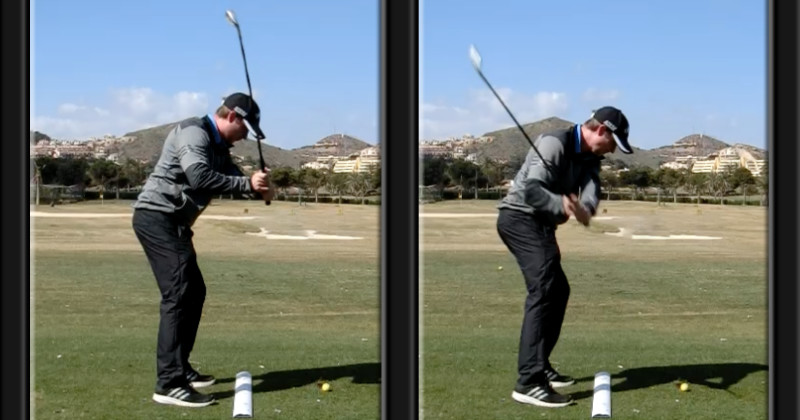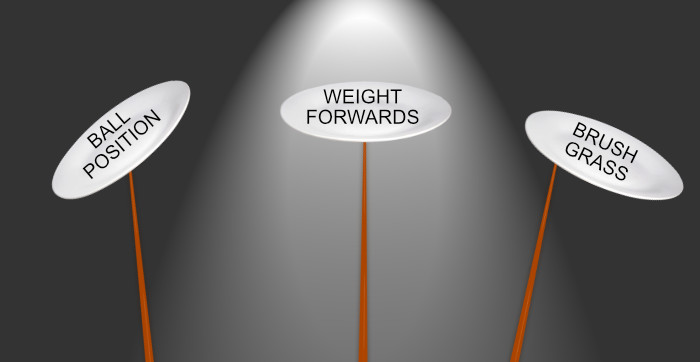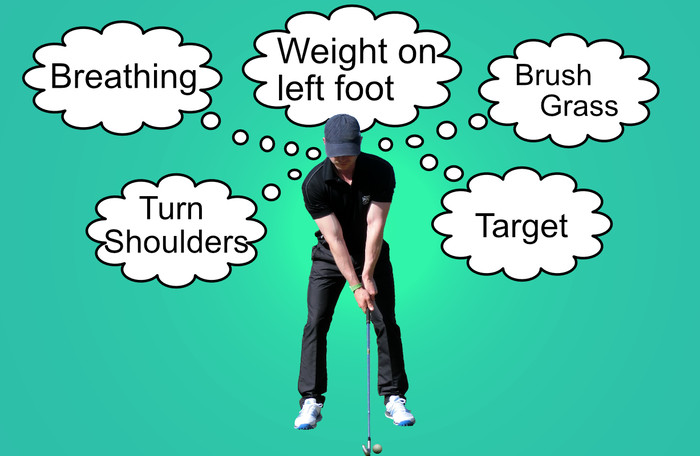Teaching chipping to a group of beginners recently reminded me of how difficult golf can be to learn.
As a beginner, we have so much that we need to do in order to hit our first good shots. We could get a million and one things right, but still blade the ball across the green if we are simply lacking one element (such as forgetting to brush the grass).
But, as humans, we can only deal with small amounts of information at any given time. This poses a tremendous problem for us when we have to learn all of the things necessary to play quality golf.
Chipping Example
As a really basic example which most readers will understand/relate to – when we first learned to chip, we were probably taught 3 basic things.
 Brush the grass – a necessary pre-requisite to get the ball on the clubface and get the ball to loft in the air and land on the green with control
Brush the grass – a necessary pre-requisite to get the ball on the clubface and get the ball to loft in the air and land on the green with control- Weight forward – it can be very difficult to strike the ball effectively with your weight on your back foot. Therefore, placing more weight on the front foot can move the ground contact point to a more acceptable position
- Ball position – while more advanced players can move the ball around to change trajectory, spin and strike, a beginner is well served just by placing the ball in the middle of the stance.
So, effectively, the mantra for a beginner would become "ball middle, weight forward, brush the grass”.
Plate Spinning
The problem is, even though this information is relatively basic (most people reading this are “beyond” this level of info), it can be quite a lot to process for a beginner if is the first time they have heard it.
If you don’t believe me, go and learn something new. You’ll see how difficult it is to hold 3 bits of new info in your brain at once.
So the story usually goes
 Player remembers to get weight forward, but then places the ball too far forward in their stance and forgets to brush the grass.
Player remembers to get weight forward, but then places the ball too far forward in their stance and forgets to brush the grass.- They then fix the ball position and brush the grass, but they do so with their weight on their back foot because they forgot that.
- They then remember to put their weight forward and brush the grass, but they forget the ball position
What….a…..fricking…..nightmare. It’s the golf equivalent of plate-spinning. The more we focus on one plate (or idea), the “unattended” plates can crash and fall.
So, what’s the solution?
Deal With It
A small but important note…..
We have to understand that, when learning something new, we may not perform it great at first. This is why we practice – over time, the things which require a lot of mental focus and attention become more automatic and can be done without thought.
For example, do you have to think hard about getting into a certain app on your mobile phone? Not if you have accessed it hundreds or thousands of times – it will almost be reflexive to you now.
However, until that time comes, we may have to deal with the fact we can’t do something perfectly straight away.
In scenarios where 2 or three things must occur to hit a quality shot, we may have to accept that we might only be able to get one of those things correct initially. You will be able to deal with/mentally attend to the other elements later.
Prioritize Improvement
On that note, dealing with multiple changes/swing additions may mean that you place them in order of priority.
For example, it’s pointless working on controlling the size of your chipping stroke (to control distance) if your ground contact is all over the place.
If you are chunking and thinning balls, your brain is going to have a real hard time figuring out how big a swing you need to make to get the ball to your target.
In the video in the example, you would be better off prioritizing “quality of ground contact” first.
From there, when the ball is now flying a consistent distance, your brain can more easily work out whether you need a bigger or smaller swing. In fact, most of the swing size will “self-organize” as a response to the consistent contact.
In my experience, most amateurs move on to overly complicated (and often irrelevant things) before they have even basic competency in simpler, more important things (such as ground strike).
Routine Thoughts
Another way around the issue is to have a routine where you set in place some things which don’t require conscious thought first, followed by a swing thought.
In our chipping example,
- First, placing the ball in the middle of the stance, then forgetting about it
- Now direct your attention to placing more weight on the left leg – something which (when set) would not require you to consciously think of it.
- Finally, direct all your attention to brushing the grass in the right place during the stroke.
By using this above routine/method, we can start to manage more than one change at a time, while only having to really focus on one thing at any one time.
Oppose this to trying to think of all of the above at once, while hitting the ball.
It’s a small change, but it can be very powerful.
Combined Focuses
Something I have become very good at over the years as a coach is to get players to make several positive changes at once with one swing focus.
For example, if I ask someone to "try to gently cut (this) part of the grass in (this) direction”
I can create a positive change in
- Swing path
- Clubface to path relationship (and hence curvature)
- Low point position
- Arc height
- Ground contact location
- Swing plane
- Body sequencing
- Face strike location
The player doesn’t realize it, but the simple and singular focus is giving rise to all of those changes simultaneously.
I usually try to combine this with the motor learning research and make those focuses external (outside of our body) as it can help long term success and coordination of all the movements.
Learn More
Golf is complex, but my approach has managed to resolve this complexity through using certain tasks.
As stated above, you can often fix many issues with a singular focus and get your game back on track quickly.
I detail many of these ideas in The Strike Plan.
It includes multiple skill drills which can create desired changes using very little thought. This is why players around the world are loving it and seeing success. If you want to find out more about The Strike Plan, click here.

